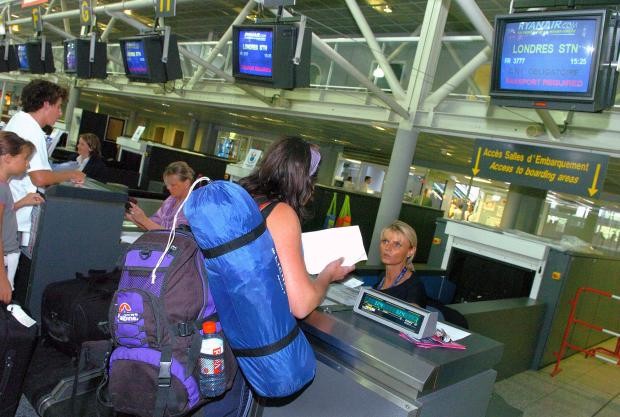
In this photo, Aug. 11, 2006, passengers en route to London check in at Biarritz airport, southwestern France. US and European officials will discuss Wednesday, May 17, 2017, plans to broaden a US ban on in-flight laptops and tablets to include planes from Europe. (Photo by BOB EDME / AP)
BRUSSELS — US and European officials will discuss Wednesday plans to broaden a US ban on in-flight laptops and tablets to include planes from Europe.
The move would create logistical chaos on the world’s busiest corridor of air travel — as many as 65 million people a year travel between Europe and North American on over 400 daily flights, many of them business travelers who rely on their electronics to work during the flight.
The ban would dwarf in size the current one, which was put in place in March and affects about 50 flights per day from 10 cities, mostly in the Middle East.
Airlines have said it is merely a matter of time before the ban is put in place, but the prospect has alarmed officials in the European Union, who want to know more about any new threats and the disruption such a move would create.
There is also the question of the relative safety of keeping in the cargo area a large number of electronics with lithium batteries, which have been known to catch fire.
Experts say a bomb in the cabin would be easier to make and require less explosive force than one in the cargo hold. Baggage in cargo usually goes through a more sophisticated screening process than carry-on bags.
The original ban focused on certain countries because their equipment to screen carry-on bags is not as effective as machines in the US, analysts say.
Officials from the US Department of Homeland Security met last week with high-ranking executives of the three leading US airlines – American, Delta and United – and the industry’s leading US trade group to discuss expanding the laptop policy to flights arriving from Europe.
The airlines still hope to have a say in how the policy is put into effect at airports to minimize inconvenience to passengers. The initial ban on passengers bringing large electronics devices into the cabin hit hardest at Middle Eastern airlines.
Emirates, the Middle East’s largest airline, this month cited the ban on electronics as one of the reasons for an 80 percent drop in profits last year. It said the ban had a direct impact on demand for air travel into the US and it faced rising costs from introducing complimentary laptop loans to some passengers.